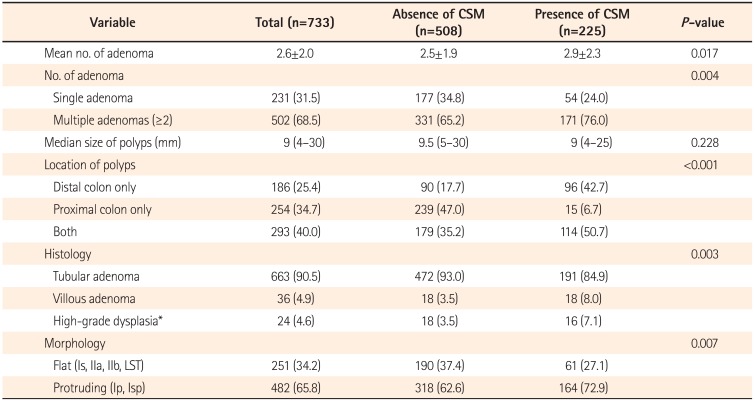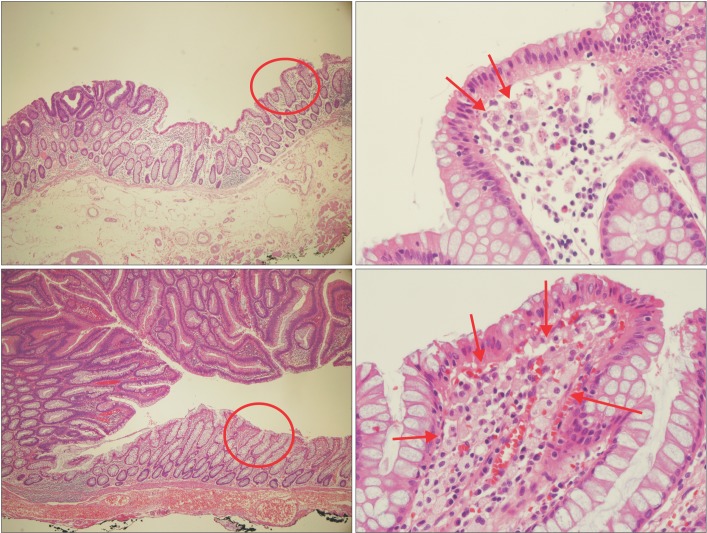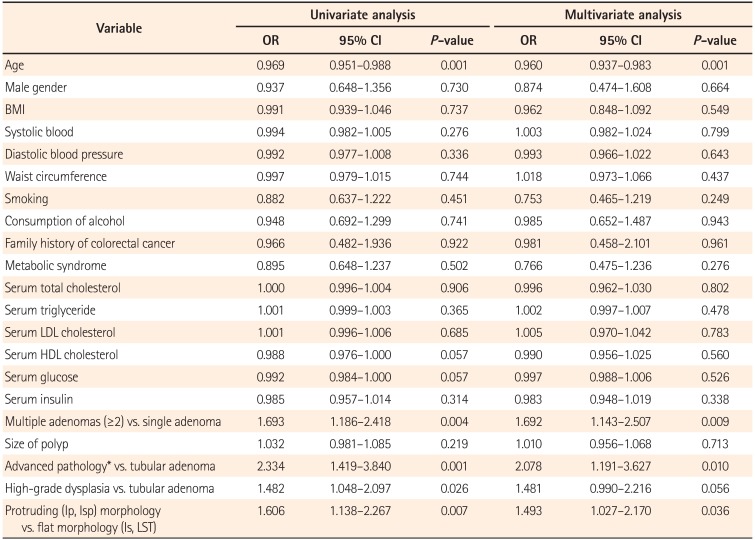1. Nakasono M, Hirokawa M, Muguruma N, et al. Colorectal xanthomas with polypoid lesion: report of 25 cases. APMIS. 2004; 112:3–10. PMID:
14961968.

2. Okano A, Takakuwa H, Nakamura T, Ohana M, Kusumi F, Nabeshima M. Rectosigmoid xanthoma as a predictive marker for sporadic rectosigmoid cancer. J Clin Gastroenterol. 2011; 45:837–838. PMID:
21633307.

3. Miliauskas JR. Rectosigmoid (colonic) xanthoma: a report of four cases and review of the literature. Pathology. 2002; 34:144–147. PMID:
12009096.

4. Shatz BA, Weinstock LB, Thyssen EP, Mujeeb I, DeSchryver K. Colonic chicken skin mucosa: an endoscopic and histological abnormality adjacent to colonic neoplasms. Am J Gastroenterol. 1998; 93:623–627. PMID:
9576459.

5. Weinstock LB, Shatz BA, Saltman RJ, Deschryver K. Xanthoma of the colon. Gastrointest Endosc. 2002; 55:410. PMID:
11868018.

6. Moran AM, Fogt F. 70-year-old female presenting with rectosigmoid (colonic) xanthoma and multiple benign polyps - case report. Pol J Pathol. 2010; 61:42–45. PMID:
20496273.
7. Delgado Fontaneda E, Basagoiti ML, Aperribay A, Ruiz Rebollo L, Moretó Canela M. Xanthoma of the colon. Rev Esp Enferm Dig. 1992; 82:203–204. PMID:
1419323.
8. Remmele W, Beck K, Kaiserling E. Multiple lipid islands of the colonic mucosa. A light and electron microscopic study. Pathol Res Pract. 1988; 183:336–346. PMID:
3420034.

9. Bejarano PA, Aranda-Michel J, Fenoglio-Preiser C. Histochemical and immunohistochemical characterization of foamy histiocytes (muciphages and xanthelasma) of the rectum. Am J Surg Pathol. 2000; 24:1009–1015. PMID:
10895824.

10. Nowicki MJ, Bishop PR, Subramony C, Wyatt-Ashmead J, May W, Crawford M. Colonic chicken-skin mucosa in children with polyps is not a preneoplastic lesion. J Pediatr Gastroenterol Nutr. 2005; 41:600–606. PMID:
16254516.

11. El-Hodhod MA, Soliman AA, Hamdy AM, Abdel-Rahim AA, Abdel-Hamid FK. Fate and ultra-structural features of chicken skin mucosa around juvenile polyps. Acta Gastroenterol Belg. 2011; 74:17–21. PMID:
21563649.
12. Guan J, Zhao R, Zhang X, et al. Chicken skin mucosa surrounding adult colorectal adenomas is a risk factor for carcinogenesis. Am J Clin Oncol. 2012; 35:527–532. PMID:
21654311.
13. Schlemper RJ, Riddell RH, Kato Y, et al. The Vienna classification of gastrointestinal epithelial neoplasia. Gut. 2000; 47:251–255. PMID:
10896917.

14. Viera AJ, Garrett JM. Understanding interobserver agreement: the kappa statistic. Fam Med. 2005; 37:360–363. PMID:
15883903.
15. Lee KH, Kim HC, Yu CS, Myung SJ, Yang SG, Kim JC. Colonoscopic surveillance after curative resection for colorectal cancer with synchronous adenoma. Korean J Gastroenterol. 2005; 46:381–387. PMID:
16301852.
16. Moon CM, Cheon JH, Choi EH, et al. Advanced synchronous adenoma but not simple adenoma predicts the future development of metachronous neoplasia in patients with resected colorectal cancer. J Clin Gastroenterol. 2010; 44:495–501. PMID:
20351568.

17. Keum B, Yoon TJ, Choi JH, et al. Clinical value of distal colon polyps for prediction of advanced proximal neoplasia: the KASID prospective multicenter study. Intest Res. 2005; 3:121–126.
18. Kim IW, Myung SJ, Do MY, et al. Western-style diets induce macrophage infiltration and contribute to colitis-associated carcinogenesis. J Gastroenterol Hepatol. 2010; 25:1785–1794. PMID:
21039842.

19. Cowey SL, Quast M, Belalcazar LM, et al. Abdominal obesity, insulin resistance, and colon carcinogenesis are increased in mutant mice lacking gastrin gene expression. Cancer. 2005; 103:2643–2653. PMID:
15864814.

20. Aleksandrova K, Boeing H, Jenab M, et al. Metabolic syndrome and risks of colon and rectal cancer: the European prospective investigation into cancer and nutrition study. Cancer Prev Res (Phila). 2011; 4:1873–1883. PMID:
21697276.

21. Lukas M. Inflammatory bowel disease as a risk factor for colorectal cancer. Dig Dis. 2010; 28:619–624. PMID:
21088413.

22. Niess JH, Adler G. Enteric flora expands gut lamina propria CX
3CR1
+ dendritic cells supporting inflammatory immune responses under normal and inflammatory conditions. J Immunol. 2010; 184:2026–2037. PMID:
20089703.
23. Laoui D, Van Overmeire E, De Baetselier P, Van Ginderachter JA, Raes G. Functional relationship between tumor-associated macrophages and macrophage colony-stimulating factor as contributors to cancer progression. Front Immunol. DOI:
10.3389/fimmu.2014.00489. Published online 7 October 2014.

24. Vendramini-Costa DB, Carvalho JE. Molecular link mechanisms between inflammation and cancer. Curr Pharm Des. 2012; 18:3831–3852. PMID:
22632748.

25. Cortez-Retamozo V, Etzrodt M, Newton A, et al. Origins of tumor-associated macrophages and neutrophils. Proc Natl Acad Sci U S A. 2012; 109:2491–2496. PMID:
22308361.

26. Nowicki MJ, Subramony C, Bishop PR, Parker PH. Colonic chicken skin mucosa: association with juvenile polyps in children. Am J Gastroenterol. 2001; 96:788–792. PMID:
11280552.
27. Hong SP, Kim TI, Kim HG, et al. Clinical practice of surveillance colonoscopy according to the classification of colorectal intraepithelial neoplasia in Korea: high-grade dysplasia/carcinoma in situ versus intramucosal carcinoma. Intest Res. 2013; 11:276–282.









 PDF
PDF ePub
ePub Citation
Citation Print
Print


 XML Download
XML Download